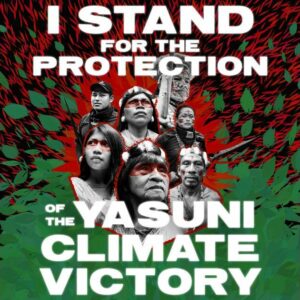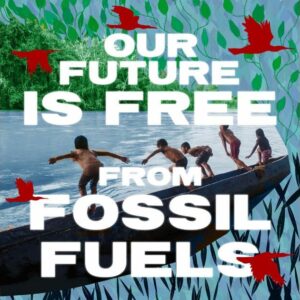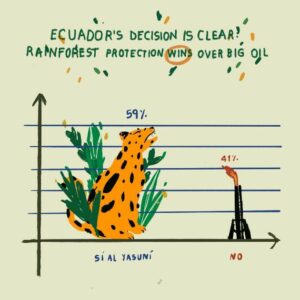This story was originally published in Bloomberg.
___
Every few days, Nixon Andy grabs his spear, packs up his drone and walks deep into the Amazon rainforest on a two-day expedition to search for illegal loggers, miners and hunters.
Andy, 26, is a member of the A’i Cofán in northern Ecuador, an Indigenous community that has taken the policing of their land into their own hands. They rely on their ancestral knowledge of the rainforest, but have also more recently begun incorporating modern technology such as drones, trap cameras and GPS devices that run on renewable power.
“We have always believed the land we live in doesn’t belong to the state, it belongs to us and to our elders,” Andy says. “We inherited this land from them, and our role is to defend it and to take care of it for future generations.”
Deploying high-tech surveillance tools in one of the deepest corners of the Amazon rainforest highlights how technological advances can be used to prevent deforestation and other illegal activities that damage ecosystems. Doing so can help protect traditional ways of life. The A’i Cofán, who live in the Sucumbíos province bordering Colombia, decided to form their own guard force in 2017. The group, which currently includes about 30 people, patrols the rainforest to record cases of illegal destruction, which they report to the Ecuadorian authorities.
Indigenous people are essential to achieve the goal of protecting a third of the world’s land and waters by 2030 that countries agreed to last year at a United Nations-sponsored biodiversity summit in Canada. While they’re often portrayed as victims of climate change and activities such as mining and agriculture, diplomats at the conference acknowledged that Indigenous people are incredibly effective custodians of their land because they have lived in harmony with those ecosystems for generations. In Ecuador, Indigenous communities hold land rights to vast areas of Amazon territory that make up the country’s eastern half.
“Since we started using these tools, the invasion of illegal miners has slowed down. They’re dissuaded by the constant presence of our Indigenous guards,” says Andy, who appears in a new documentary directed by Dominic Gill, one of the winners of the Bloomberg Green Docs competition in 2022. The film was produced in partnership with the Honnold Foundation, a US nonprofit.
Andy and his people belong to the Ceibo Alliance — a larger organization that includes four different Indigenous groups in the area. Over the years, the group has received surveillance equipment from the nonprofit Amazon Frontlines, which partners with Indigenous groups in the Upper Amazon. Solar-powered microgrids donated by the Honnold Foundation and installed in sheds across the remote rainforest allow the guards to charge their equipment on the go, helping them to do longer patrols and cover more land.
“Solar made all the difference because up until now, access to the grid was conditional to allowing extractive activities like mining, oil drilling or palm oil plantations in our territory,” says Hernán Piaguaje, a founding member of the Ceibo Alliance and a member of its leadership council. “Some communities have fallen into these traps out of necessity.”
Speaking from his home on the bank of Aguarico River, a 43-year-old member of the Siekopai community, said the deployment of solar energy in the area could have an even larger impact. Those who have electricity now access it through diesel-powered generators and feeding them is often the first link in a long chain of events that ultimately leads to environmental damage.
“To pay for the fuel, people go and hunt an animal or chop down a tree, then they go to the market and sell it,” he says. “A solar system would give the community more autonomy and more space and time to focus on activities that don’t damage the land.”
Amazon Frontlines has trained 170 Indigenous rangers to use high-resolution satellite imagery and GPS to track culprits, and operate drones and camera traps to catch them in action, says Mitch Anderson, the group’s founder and executive director. The evidence gathered by these self-appointed rainforest guardians helped support a complaint they filed in court in 2018. The Constitutional Court, Ecuador’s top court for human rights issues, ruled in January 2022 that government authorities had violated the A’i Cofán’s rights to prior consent by granting mining concessions, setting a precedent strengthening rights of the nation’s 14 recognized Indigenous peoples.
The landmark decision was another sign of growing resolve to protect the world’s largest rainforest. Colombian President Gustavo Petro’s clean energy push includes refusing to issue new oil exploration licenses, while Brazil’s leader Luiz Inácio Lula da Silva has pledged to end illegal deforestation by 2030. Illegal logging rose to a record high in 2022 under his predecessor Jair Bolsonaro.
In Ecuador, President Guillermo Lasso has relaxed red tape around mining exploration and concessions, but court decisions and a growing public backlash against extractive activities might force the country’s next leader to reverse course. In August, 59% of Ecuadorians voted in favor of shutting down a major oilfield in the Amazon, while voters in Quito banned new mining concessions in parts of the capital’s metropolitan district. Those decisions, ahead of a run-off presidential election in October, have sent a strong signal to the candidates — a socialist and a businessman in the banana industry — about the need to prioritize environmental protection.
But the reality on the ground remains tough for Indigenous guards. Their leaders face constant threats from the illegal actors, who sometimes carry firearms. Complaints to state authorities have to go through a time-consuming process. There are no programs or funds to restore the environment that has already been damaged and the fate of the land they live on can change with every election.
“I am determined to defend my territory, just as my ancestors did,” says Morelia Mendúa, an A’i Cofán youth activist from the Sinangoe community. If Indigenous people don’t act, “we will be left with nothing,” she says.
Do you have a compelling climate story? The Bloomberg Green Docs competition is open to all eligible filmmakers who would like to compete to win a $25,000 grand prize for a short climate documentary. Learn more.




